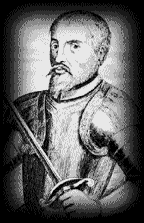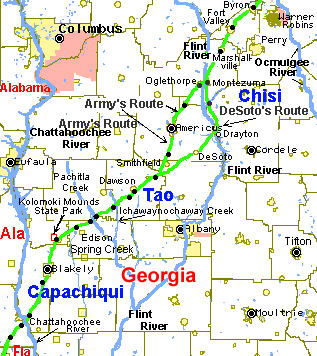 |
This, too, was once one of the Western places
- how the Georgia landscape maps onto the WWW.
At the beginning of Joseph Conrad's Heart of Darkness, Marlowe reminds his listeners that the Congo was not the only frontier: "This, too, was one of the dark places of the earth." He was referring to much earlier days on the Thames, of course, to the Roman invasion of Britain.
The Chattahoochee River. While we tend to think of places like Africa or the American West as the definitive wilderness experience, the history of civilizations is edged with an almost permanent frontier. In 1540, Hernando deSoto led 600 Spanish soldiers, businessmen, entrepreneurs, and priests on a journey through Georgia. We can only imagine, what with encounters with the Creek and Cherokee tribes, dark forests, dangerous swamps, and unreliable food supplies, how hostile this now-familiar terrain must have seemed to them.
DeSoto's group were "dying of hunger, without a road, with continual rain, the rivers swelling and narrowing the land, and without hope of towns or knowledge of where they had to go to look. . . ." At the time, Georgia was the wilderness to Europeans in every sense.
DeSoto's Route in Green. Garcilaso de la Vega, the chronicler, mentions "the great necessities that our Castilians suffered in this discovery." In the 21st century, we can trace the route of deSoto on a map, drive safely over the river on the freeway - but for deSoto and his men, and for generations of early Georgians, the landscape consisted of formidable boundaries everywhere. On the ground, walking or riding a horse, a river was always a big stretch of treacherous water. In a very real sense, we have succeeded, by the end of the 20th century, in domesticating much of the physical, earthly frontier. But we are edge effect creatures, always searching for new opportunities. In 1969, many people believed that the new ground would be our galaxy - perhaps colonies on the moon which challenged our ability to live in weightless and airless spaces. Instead, we have turned inward - mapping and colonizing the multiverse of knowledge. The rivers, though, are not less daunting or the swamps less treacherous. [On the other hand, the wonder and richness of part of this multiverse, the WWW, is evident in the fact that one could find the actual narrative of deSoto's travel, maps, illustrations, background, and commentary in a few hours.]
I am indebted to Donald E. Sheppard's wonderful site DeSoto's Trail thru the Southeast, illustrated by Cheryl Lucente <http://www.floridahistory.com/inset7.html> |
 |
|
© Marjorie Coverley Luesebrink // The Lore and Lay of E-land // Kessesaw State University, March, 2002 |




